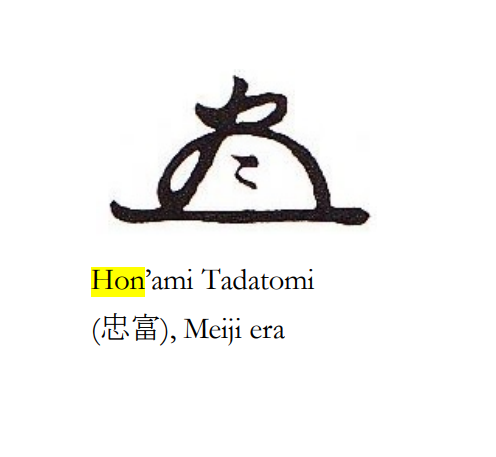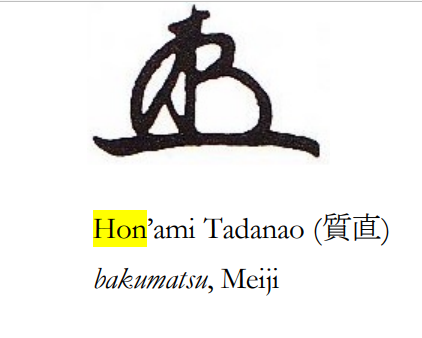-
Posts
12,902 -
Joined
-
Last visited
-
Days Won
154
Everything posted by Bruce Pennington
-
There is a chance of that. Since we cannot know for sure, your guess on it is just as good as the guys that will say it's a fake/reproduction.
-

MORINOBU & KANENOBU
Bruce Pennington replied to Swords's topic in General Nihonto Related Discussion
They were both RJT. Considering the average - 10-15 per month - that's a sword every 2 to 3 days! They must have had large teams working for them. -

MORINOBU & KANENOBU
Bruce Pennington replied to Swords's topic in General Nihonto Related Discussion
Thomas cited something about a single smith, with 2 apprentices that could make 5 per month: -

MORINOBU & KANENOBU
Bruce Pennington replied to Swords's topic in General Nihonto Related Discussion
George Trotter sited a book from 1994 that said RJT smiths were making 10 per month: -

MORINOBU & KANENOBU
Bruce Pennington replied to Swords's topic in General Nihonto Related Discussion
Here, Trystan quotes a book on Yasukuni sword production: "In the chapter titled "CHANGE IN THE NUMBER OF SWORDS PRODUCED" in The Yasukuni Swords, it is mentioned: "Nevertheless, Yasukuni smiths engaged in sword forging with maximum effort, always seeking to improve their techniques and produce the highest number of swords possible. They employed a sword forging method called 'makuri-gitae,' which is one of the relatively less time-consuming traditional methods, and it favored a hamon in suguha. This method seemed the most appropriate to the circumstances, and suited the forging of practical swords such as gunto." It also mentions that "each smith produced about ten swords per month around 1935, and succeeded in increasing the monthly output to fifteen swords around 1940." -

MORINOBU & KANENOBU
Bruce Pennington replied to Swords's topic in General Nihonto Related Discussion
I recall reading that smiths were able to put out 8-10 swords per month. Don't know details on how many apprentices or whether traditional or not. -

Koa Isshin With Nthk Papers
Bruce Pennington replied to PNSSHOGUN's topic in Military Swords of Japan
This one just has registration paper, so not "papered" and easy to understand. Thanks to @Ontario_Archaeology for bringing up. Found on this Yahoo Auction. Corrosion take taken the date, and no serial number posted. @BANGBANGSAN @Kiipu -
Can we see the rest of the blade and fittings? Partial Showa stamp at top. Puts the blade in the 1935-1942 range, with most of them made in 1940-41. I only have 5 of his blades on file, and one is dated Feb 1941.
-

Appraiser for this Kinzogan Mei kao
Bruce Pennington replied to Lewis B's topic in Translation Assistance
@Markus might be able to help. I went through his list of Honami kao for sayagaki HERE, but it's hard to go from the hand-drawn kao to this nakago style. Here are some that are close: -

MANTETSU INSTRUCTOR'S TALISMAN TANTO
Bruce Pennington replied to KungFooey's topic in Military Swords of Japan
Dee, thanks for the post! I had Volker's on file but these 2 make a great set of 3 now. @Volker62 - thanks for the clarification of the Wish Jewel. I erroneously had it in the Stamps doc as a flaming jewel. Is anyone able to translate that odd date on the second tanto? -
You'll find several examples this this style Here: Though, I cannot tell you the history of it. I believe it goes way back in time. The bird is a pheasant, I think.
-
Ah, I see from looking back at Ian's post, there were some legit hangers with that sculpted design. So, that is not a red flag.
-
Hi Laird! I've enhanced the photo of the tsuka. The wrapping is Chinese style - all the folds go in the same direction. Japanese wrap alternate directions The sword was likely made in China. Now whether during war, for Japanese use, or collaborators, or a replica/fake impossible to know. To be honest, most like this are labeled as replica/fakes. Are you certain the gold is inlaid brass vs painted? If inlaid, you can use all the normal blade cleaning techniques, like chogi power, pure alcohol, and oil. You can safely remove the mekugi (peg) by gently moving, or get underneath, the wrap that covers one end while you tap it out.
-
It's interesting, too, that #2 & 6 have sculpted shape to the end piece (sorry don't know terms), while the others are all square/retangular.
-
FWIW, I have a few Kanetaka on file and none use the 2 kanji mei like this, nor that style "Kane". I'm not saying it's gimei or fake, as I've never seen a faker try to imitate the Showa stamp. Just unusual.
-

is this a real ww2 Japanese naval sword
Bruce Pennington replied to zashmon's topic in Military Swords of Japan
I hope one of our guys gets it. I don't have the hobby cash, or I'd go for it, even if it is overpriced. Yes, this is now the second of these with sale papers from the 8th Army PX. -

SNLF gunto on Hainan Island 1941
Bruce Pennington replied to MarcoUdin's topic in Military Swords of Japan
Good discussion held by Austin Adachi on this thread - Album - The Life of a Shanghai SNLF Officer; Wehrmacht-awards. Discussing their use of Army swords, he said: " I've been looking at IJN documents a bit to try and figure out their sword situation more. The IJN purchased some 300 swords in 1932 which appear to be army sabers. Later in the mid 1930's the Shanghai SNLF kept a supply of 33 "Gunto Model A" (軍刀甲) to issue to warrant officers and above. We can see in photos it's often line commissioned officers carrying Type 94 swords and non-line and warrant/special duty officers carrying Army sabers (Type 19s?) unless they have their own they brought with them. I'm hoping to find navy purchase records for Type 94 swords in the future." Front row left to right: Supply Chief, Chief of Staff, Commander, Medical Chief, Engineering Chief You can see that they were even using Army tassels: -

Where is the audience for Showa Gunto?
Bruce Pennington replied to Peter Bleed's topic in Military Swords of Japan
Not to get your thread off track, Peter, but I did find the thread about papered Mantetsu. Here: In the four pages you'll see 2 Koa Isshin that recieved Hozon papers, both Spring 1941 blades; one KA 89, the other RE 476. I believe there are a couple other examples of non-stamped WWII blades with papers, too. You can go directly to them with these links: Koa Isshin RE 476 Papered - Japanese-sword-katana.jp Koa Isshin KA 89 Papered - Japanese-sword-katana.jp -

Where is the audience for Showa Gunto?
Bruce Pennington replied to Peter Bleed's topic in Military Swords of Japan
Dang, that's really messed up! It's not normal to see a stamp right in the mei, but I have seen it before. The prefecture isn't even readable due to the effort to obliterate the stamp. -

Where is the audience for Showa Gunto?
Bruce Pennington replied to Peter Bleed's topic in Military Swords of Japan
I could see the obliterated Showa stamp on the Ichinori. Couldn't make one out on that first one, though. Thanks for the links, Dee! -

Where is the audience for Showa Gunto?
Bruce Pennington replied to Peter Bleed's topic in Military Swords of Japan
Peter, I'll have to do some rooting around on Ohmura's site, but he has a page where he strongly agues that WWII swords, showato, were simply the latest evolution of the Japanese sword and deserve respect from the sword community as the latest version of Nihon (Japan) To (sword). Now, whether he has made a dent in Japan or not, I cannot say. Guys that live there, and guys that live among the NTHK & NBTHK worlds would have more of a feel for that. I would echo Robert's point about the slowly growing number of war swords that are getting papered. A crack has opened in the nihonto dam and trickles of WWII swords are slowly leaking through. I'm flattered that you mention my work, but seriously there are many of us who are pressing hard into this part of Sword World. I do have an appreciation for all those who work hard to uphold traditions of any kind, whether that be swords, or hand made cakes, or ballroom dancing. But I can vouch for the fact that many commercially made cakes i have eaten were pretty darn good; and the majority of people prefer dancing of almost everything else but ballroom. Maybe time and public attention will turn the tide on recognition for the merits of WWII swords. -
We've seen some 'hail in rain' designs before, but I thought I'd post this one, found on a late-war T98 on ebay
-
Textbook fake with all the red flags. For sale on ebay, not even going to post the link. Don't even have to enlarge on each section of the sword. I could see from the expanded shot that the haikan was mounted too far down the saya, for starters:
-

A Pretty Crude Late War Gunto.
Bruce Pennington replied to MacTheWhopper's topic in Military Swords of Japan
Ok, then not necessary. Only do it if it's something you want to pursue. -

A Pretty Crude Late War Gunto.
Bruce Pennington replied to MacTheWhopper's topic in Military Swords of Japan
It strikes me as an effort by collaboration sword makers to make an NCO sword. Collaborators had NCO ranks, too. It's just something we've never seen discussed. Nor do we know enough about, nor have enough wartime photos of, to base real decisions on. We all know what the nakago will likely look like, but you ought to pop the tsuka off on the chance there is a Java mei. If so, it locks it in. Without it, we are back to speculation.














